
Chemistry
10th Edition
ISBN: 9781305957404
Author: Steven S. Zumdahl, Susan A. Zumdahl, Donald J. DeCoste
Publisher: Cengage Learning
expand_more
expand_more
format_list_bulleted
Question
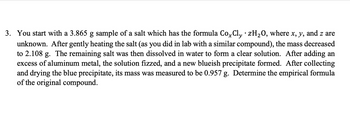
Transcribed Image Text:3. You start with a 3.865 g sample of a salt which has the formula Cox Cly · zH₂O, where x, y, and z are
unknown. After gently heating the salt (as you did in lab with a similar compound), the mass decreased
to 2.108 g. The remaining salt was then dissolved in water to form a clear solution. After adding an
excess of aluminum metal, the solution fizzed, and a new blueish precipitate formed. After collecting
and drying the blue precipitate, its mass was measured to be 0.957 g. Determine the empirical formula
of the original compound.
Expert Solution
This question has been solved!
Explore an expertly crafted, step-by-step solution for a thorough understanding of key concepts.
This is a popular solution
Trending nowThis is a popular solution!
Step by stepSolved in 3 steps with 1 images

Knowledge Booster
Learn more about
Need a deep-dive on the concept behind this application? Look no further. Learn more about this topic, chemistry and related others by exploring similar questions and additional content below.Similar questions
- wum Oxide and Sr(IO3)2•H20 Name: POST-LAB QUESTIONS continued Section a. The solubility of barium iodate monohydrate in 25°C water is 0.028 g per 100. mL of water. Calculate the solubility, or in other words, the proportion of how much product would dissolve if you rinsed it with 125 mL of 25°C distilled water. b. Suppose you have 4.832 g of product and then rinse it with 125 mL of 25°C water, use the answer in 2a to calculate how much product would you expect to isolate. C. The solubility of barium iodate monohydrate in 4°C water is 0.010 g per 100 mL of water. Calculate the solubility, or in other words, how much product would dissolve if you rinsed it with 20.0 mL of 4°C distilled water. d. Suppose you have 4.832 g of product and then rinse it with 20.0 mL of 4°C water, use the answer in 2c to calculate how much product would you expect to isolate. e. Using your answers from (b) and (d), calculate the percent error or percent difference as a result of accidentally using the 25°C…arrow_forwardWrite the balanced equation for the reaction of aqueous Pb(ClO3)2Pb(ClO3)2 with aqueous NaI.NaI. Include phases. chemical equation: What mass of precipitate will form if 1.50 L1.50 L of highly concentrated Pb(ClO3)2Pb(ClO3)2 is mixed with 0.500 L 0.300 M NaI0.500 L 0.300 M NaI? Assume the reaction goes to completion.arrow_forwardA 50.0 mL solution of Ca(OH)₂ with an unknown concentration was titrated with 0.340 M HNO₃. To reach the endpoint, a total of 20.2 mL of HNO₃ was required. Write the balanced chemical equation for the reactionarrow_forward
- Using water, how could you distinguish between the white solids KCl and PbCl2 KClKCl will dissolve in water; PbCl2PbCl2 will not dissolve in water KClKCl will be a colorless solid; PbCl2PbCl2 will be a white solid There is no way to differentiate between the two using water KClKCl will not dissolve in water; PbCl2PbCl2 will dissolve in waterarrow_forward4. If the following values are used... Measure the mass of 0.400 g of cobalt(II) nitrate hexahydrate (Co(NO;)2 -6H2O), and dissolve it in 15.0 mL of distilled or deionized water using a clean beaker. Using a graduated cylinder, measure out 10.0 mL of a prepared 0.10-M sodium phosphate (NazPO4) solution. ... determine which compound, (Na3PO4 or Co(N03)2 ·6H2O) will be the limiting reagent. Then determine the theoretical yield.arrow_forwardTooth enamel consists of hydroxyapatite, Ca5(PO4)3OH (Ksp = 8 × 10−37). Fluoride ion added to toothpaste and also drinking water reacts with Ca5(PO4)3OH to form the more tooth decay–resistant fluorapatite, Ca5(PO4)3F (Ksp = 1.0 × 10−60). Fluoridated water has dramatically decreased cavities among children. Calculate the solubility of Ca5(PO4)3OH and of Ca 5(PO4)3F in water.arrow_forward
- Both the reactants Sodium Carbonate and the product sodium Chloride are white solids and cannot be distinguished by looking at them. Can you think of any chemical tests you could do to prove that it is not NaCI2?arrow_forwardIn the laboratory you are given the task of separating Ag* and Fe* ions in aqueous solution. For each reagent listed below indicate if it can be used to separate the ions. Type "Y" for or "N" for no. If the reagent CAN be used to separate the ions, give the formula of the precipitate. If it cannot, type "No" yes Y or N Reagent Formula of Precipitate if YES 1. HBr 2. K2SO4 3. КОНarrow_forwardWrite the balanced COMPLETE ionic equation for the reaction when KCl and Na₃PO₄ are mixed in aqueous solution. If no reaction occurs, simply write only NR. Be sure to include the proper phases for all species within the reaction.arrow_forward
- Suppose you are asked to determine the identity of a white solid. When you add water to the white solid, it dissolves and forms a clear solution. When you add a solution of Na, SO,, a white precipitate forms. Add Add H,O Na,SO, Determine the identity of the original solid. O PBCI, O MgCl, O ZNCI, O CaCl,arrow_forwardOne mL of an unknown solution is placed in a test tube and a few drops of NaOH are added and shaken well. 1 mL of aqueous NH3 is then added to the solution and shaken again. A deep blue solution is observed. What is the interpretation for this result? Select one: A. There is Iron(III) (Fe3+) present in the solution. B. There is Zinc (Zn2+) present in the solution. C. There is Copper(II) (Cu2+) present in the solution.arrow_forwardConsider the reaction of 30.0 mL of 0.235 M BaI₂ with 20.0 mL of 0.315 M Na₃PO₄. What quantity in moles of Na₃PO₄ are present in the solution?arrow_forward
arrow_back_ios
SEE MORE QUESTIONS
arrow_forward_ios
Recommended textbooks for you
 ChemistryChemistryISBN:9781305957404Author:Steven S. Zumdahl, Susan A. Zumdahl, Donald J. DeCostePublisher:Cengage Learning
ChemistryChemistryISBN:9781305957404Author:Steven S. Zumdahl, Susan A. Zumdahl, Donald J. DeCostePublisher:Cengage Learning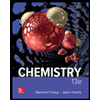 ChemistryChemistryISBN:9781259911156Author:Raymond Chang Dr., Jason Overby ProfessorPublisher:McGraw-Hill Education
ChemistryChemistryISBN:9781259911156Author:Raymond Chang Dr., Jason Overby ProfessorPublisher:McGraw-Hill Education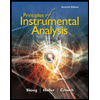 Principles of Instrumental AnalysisChemistryISBN:9781305577213Author:Douglas A. Skoog, F. James Holler, Stanley R. CrouchPublisher:Cengage Learning
Principles of Instrumental AnalysisChemistryISBN:9781305577213Author:Douglas A. Skoog, F. James Holler, Stanley R. CrouchPublisher:Cengage Learning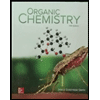 Organic ChemistryChemistryISBN:9780078021558Author:Janice Gorzynski Smith Dr.Publisher:McGraw-Hill Education
Organic ChemistryChemistryISBN:9780078021558Author:Janice Gorzynski Smith Dr.Publisher:McGraw-Hill Education Chemistry: Principles and ReactionsChemistryISBN:9781305079373Author:William L. Masterton, Cecile N. HurleyPublisher:Cengage Learning
Chemistry: Principles and ReactionsChemistryISBN:9781305079373Author:William L. Masterton, Cecile N. HurleyPublisher:Cengage Learning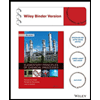 Elementary Principles of Chemical Processes, Bind...ChemistryISBN:9781118431221Author:Richard M. Felder, Ronald W. Rousseau, Lisa G. BullardPublisher:WILEY
Elementary Principles of Chemical Processes, Bind...ChemistryISBN:9781118431221Author:Richard M. Felder, Ronald W. Rousseau, Lisa G. BullardPublisher:WILEY

Chemistry
Chemistry
ISBN:9781305957404
Author:Steven S. Zumdahl, Susan A. Zumdahl, Donald J. DeCoste
Publisher:Cengage Learning

Chemistry
Chemistry
ISBN:9781259911156
Author:Raymond Chang Dr., Jason Overby Professor
Publisher:McGraw-Hill Education

Principles of Instrumental Analysis
Chemistry
ISBN:9781305577213
Author:Douglas A. Skoog, F. James Holler, Stanley R. Crouch
Publisher:Cengage Learning

Organic Chemistry
Chemistry
ISBN:9780078021558
Author:Janice Gorzynski Smith Dr.
Publisher:McGraw-Hill Education

Chemistry: Principles and Reactions
Chemistry
ISBN:9781305079373
Author:William L. Masterton, Cecile N. Hurley
Publisher:Cengage Learning

Elementary Principles of Chemical Processes, Bind...
Chemistry
ISBN:9781118431221
Author:Richard M. Felder, Ronald W. Rousseau, Lisa G. Bullard
Publisher:WILEY